2015 MoonBlog
This isn't really about the moon, I call it a moonblog because a new homepage image appears twice a month on the new and full moon. The home page shows a featured image —sometimes freshly minted, sometimes seasonal, sometimes from years past— along with improvised ruminations, something like a leisurely blog. Previous years’ entries are here for your perusal. See the links, above.
Pewter Salt & Pepper
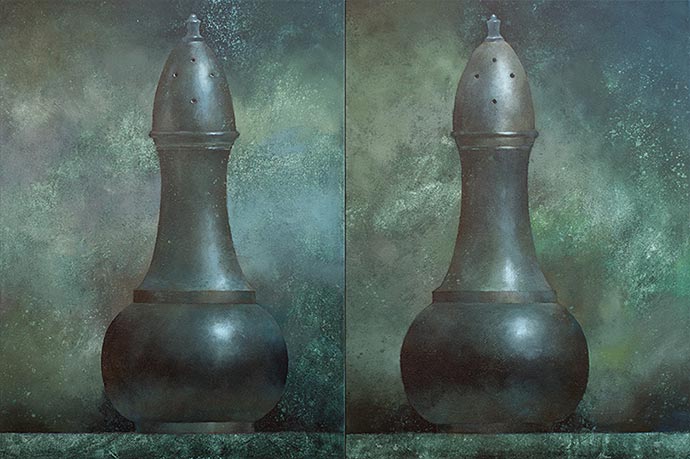
This is a recent painting of a set of pewter salt and pepper shakers. I was working on it just yesterday before delivering it to Art + Soul gallery for their 15th anniversary show. The original inspiration for this show was to coincide with a planned visit to Boulder from His Holiness the Fourteenth Dalai Lama. We didn't really expect that the Dalai Lama would come to see the show (and his doctor ordered him to cancel his tour of North America) but his visit had me thinking about simplicity. So I spent some of the past several months re-visiting a mode of painting simple objects. It's a curious thing to work in different modes. We might tend to think of this as different “styles”, but what is a style, really? I think of this process as being similar to learning songs, which as any musician knows, can be played again and again. I'm pleased with the outcome of this painting, but it was a struggle to recall its technique, like trying to remember the chords of a song not played in a long time.
New Moon ~ October 12th, 2015
Lichen
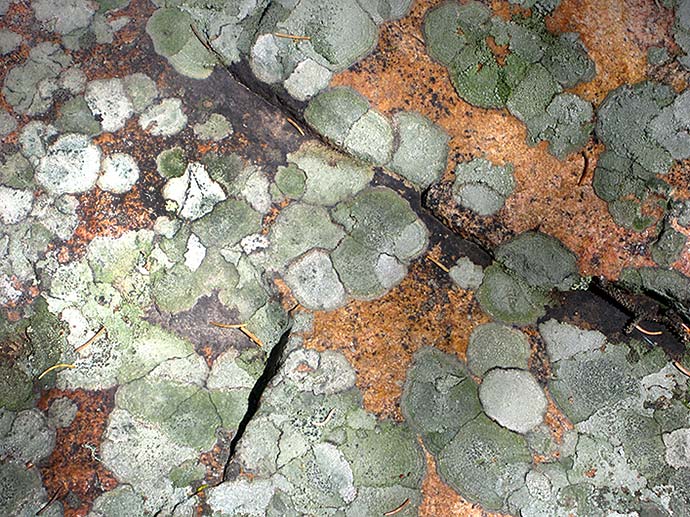
Here is a photograph of a lichen covered boulder in southern Colorado. Even though this happens to be in the San Isabel Wilderness, arrangements like these are everywhere; they can be found in any circumstances from the most pristine to the most human trodden areas. Several qualities are worth pointing out. One is the handsome color scheme, the way the cool colored lichen in its many shades is set off from the warm colored pink granite. Another quality is the pell mell arrangement of amorphous, yet harmonious shapes with a discreet sprinkling of pine needles. These and many other qualities are instructive in their being utterly devoid of artifice; they stand for themselves without effort or contrivance. Effortlessness could be useful to emulate, as long as the emulation doesn't itself become artifice; rather, effortlessness is an expression of confidence in how one is, how reality itself is.
Full Moon (Blue Moon!) ~ July 31st, 2015
Silver Cup
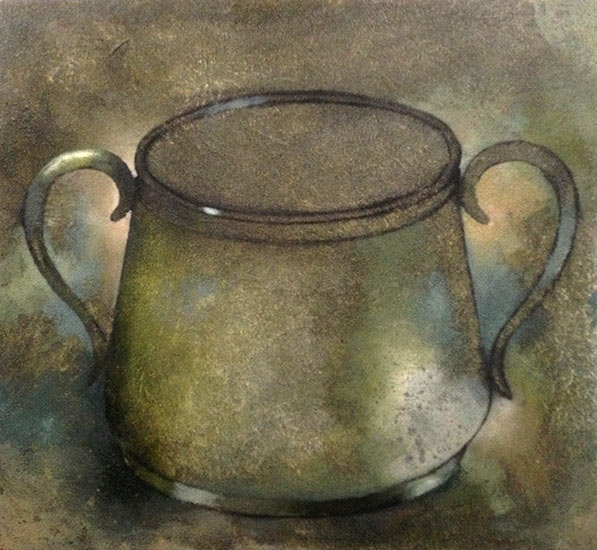
This painting came into being a few weeks ago. I'm in the process of trying to remember how to paint in a specific way that I had set aside for some years. You can see more of what I'm talking about by visiting the Vessels section of this website (see Portfolio link on the top toolbar). I'm doing this in preparation for a show coming up next fall at the Art + Soul gallery in Boulder, set to coincide with a visit from The Dalai Lama. This doesn't mean we expect him to visit the show, but it seems right to pay attention to his rocklike, simple decency. I'm also interested in reconnecting with the care and attention that it takes to paint this way because of the way it enlivens perception. One never knows where this leads, but clear seeing is its own reward.
New Moon ~ July 15th, 2015
Fog
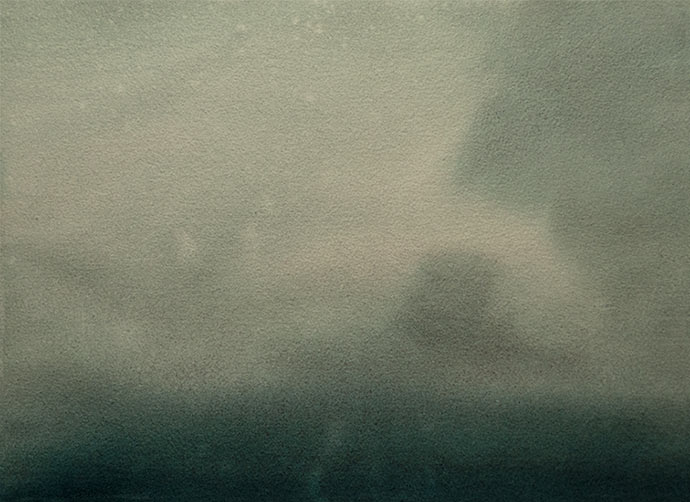
This watercolor appeared from my brush a few days ago. It has given me the idea of working on a series of fog paintings. This one is based on a condition that on fortunate occasion graces our land in southern Colorado when clouds envelop the mountains. There are places on earth called “cloud forests”, jungles wrapped in perpetual clouds at higher altitudes in equatorial zones. It’s a particular kind of ecosystem where a majority of the water is supplied by the clouds themselves. The notion of a forest in perpetual clouds seems mythic and it's easy to imagine all sorts of fairies and fiends living in the damp fragrance where nothing would be quite clearly visible. Southern Colorado is not cloud forest and the appearance of fog in such an arid climate always seems benevolent. It can also carry a most profound silence.
Full Moon ~ July 1st, 2015
Cyclamen in Slow Progress
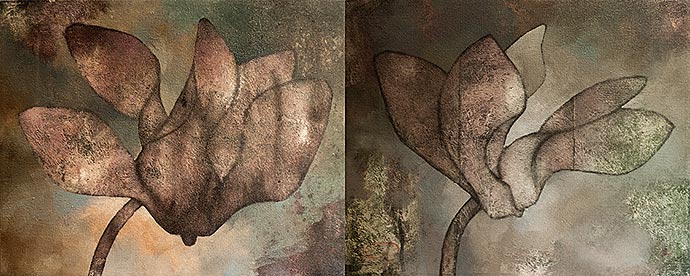
It's not unusual for a painting to find itself abandoned – sometimes for years at a time – only to be taken out and subjected to rehabilitation. These two cyclamen paintings, shown here as a diptych, were set in motion over ten years ago. They were coaxed to a certain point, sent to the now defunct Blink gallery, displayed for some weeks, and returned to my studio without comment or interest, after which they entered a long phase of silent pupation. This morning I took them out to see what could be done with them. As I worked on them I was looking at a favorite book, Cezanne: Finished, Unfinished, a now out of print book from Hatje Cantz. Unfinished paintings often seem more honest – or at least more interesting – than a polished “statement”; it's more like seeing someone at home on a Saturday morning. Maybe these paintings will go further or perhaps they'll be sent back to the puparium.
New Moon ~ June 16th, 2015
Water Stunned Fly
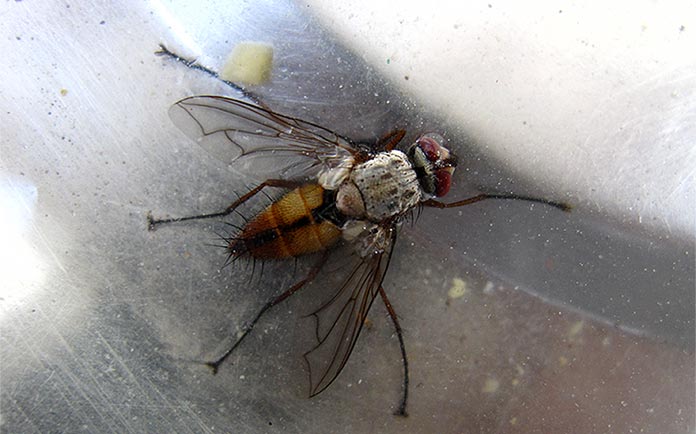
I made this photograph of a fly in a stainless steel bowl. Sometimes insects get caught in water and by all appearances have drowned. If you carefully remove them and let them dry out a bit, they'll often come right back to life. The interim period is a good time to observe them closely; sometimes I do so under a microscope. I try to be discreet, of course, with everyone all hepped up about privacy and all. Really what I'm doing is much more admiration than spying. Insects are marvels of design and the color schemes of their outfits are invariably quite fetching. Just look at her silver lamé vest and those mahogany sun glasses! And like many animals in the wild, insects are committed to fine grooming. Take the time to watch a fly smoothing its wings, plucking dust particles from its legs and feet, washing its face, and generally tidying up. Yes, I'm talking about flies here. It's difficult to think ill of them once you've spent some time with them. This is probably true about many things.
Full Moon ~ June 2nd, 2015
Fish at Tso Pema
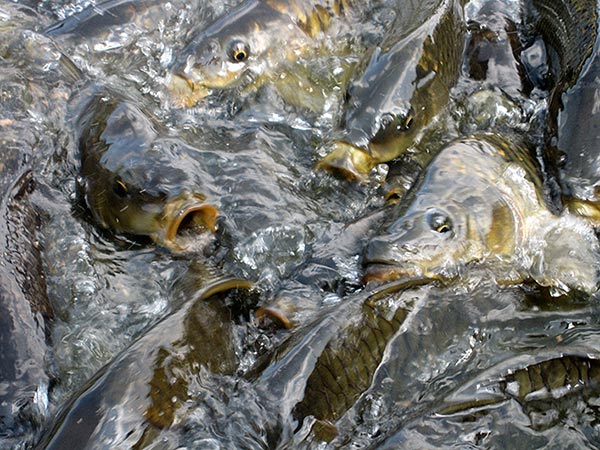
This image is a photograph of fish feeding. They live in a lake in northern India called Rewalsar, or Tso Pema in Tibetan. The lake has a centuries-old place in the Himalayan mythology and history of the illustrious 8th century Indian Buddhist teacher Padmasambhava. According to the Rikpa Wiki site, the lake at Tso Pema where these fish live came into being when, “Returning to Zahor, Padmasambhava took the royal princess Mandarava as his consort, and they then went to the Maratika cave, where for three months they practised the sadhana of longevity. The Buddha of Limitless Life, Amitayus appeared, empowered them with longevity, and blessed them as inseparable from him. They both accomplished the second vidyadhara level, ‘vidyadhara with mastery over life’. The king of Zahor and his ministers arrested Guru Rinpoche and Mandarava and burned him alive, but he transformed the pyre into a lake, and was found sitting, cool and fresh, on a lotus blossom in its centre. This lake is considered to be the Rewalsar Lake, ‘Tso Pema’, in the present-day Indian state of Himachal Pradesh. Overcome with remorse, and in homage, the king offered Padmasambhava his entire kingdom, beginning with his garments and his five royal robes.”
Little is known about the factual details of Padmasambhava’s life, much of it being told in the mythical poetic style of the time, but his influence on the development and refinement of the Buddhist tantric tradition is paramount, especially in the Himalayan region. He is thought to have been born in the Swat valley in present day Pakistan, a wild and ruggedly beautiful area of mountains, rivers, and clear lakes, ironically a contemporary stronghold for the Taliban and their psychotic version of Islam. The Swat valley is also the birthplace of Malala Yousafzai, who was shot by the Taliban in their attempt to intimidate her for her vocal advocacy of education for girls; she was fifteen at the time of the incident. She survived and has become a Nobel laureat, a global figure, eloquent in her call for educational equality.
I'm not sure how these stories interweave, or if there is any significance that both Padmasambhava and Malala Yousafzai were born thirteen centuries apart in the same river valley, or that these fish living four hundred miles away have any way of knowing anything about either one of them.
New Moon ~ May 17th, 2015
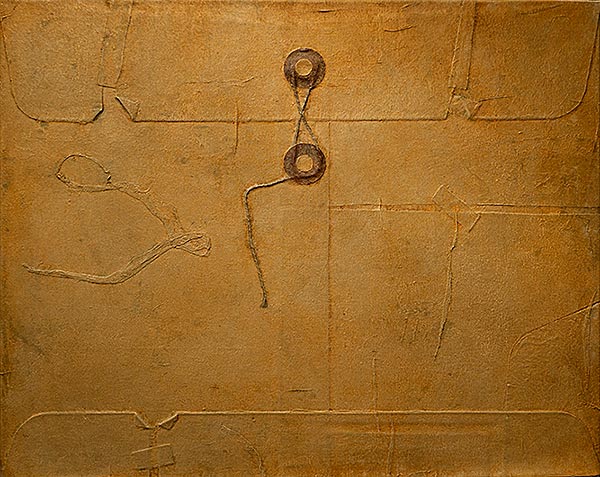
This is one of a set of three paintings I finished this week, two of which are in a show at the Westbeth Gallery in New York. The show is organized by Steve Clorfeine, a dancer and performance artist who recently wondered what to do with nearly fifty years of written letters from a lifetime of faithful correspondence with literally hundreds of people. For this show, Steve gave to participating artists bundles of letters and free reign to do whatever they pleased. The result of this is a group show of over forty artists from around the U.S. and the world. The show runs from May 2 - 17.
I'm calling these paintings Partially Restored Envelopes, Back View. For the show catalog I wrote, “I’ve always enjoyed the archaeological practice of re-assembly, the painstaking re-construction of broken, often discarded objects. The centuries-old practice of letter writing has dwindled to nearly nothing in a few short years, having been mostly discarded in favor of faster, seemingly more convenient methods. I suppose these paintings could be seen as a form of strange pop monuments or memorials to an earlier form of distance conversation.” They're 32″ x 40″, acrylic and canvas collaged on canvas.
New Moon ~ April 18th, 2015
Grumman Avenger
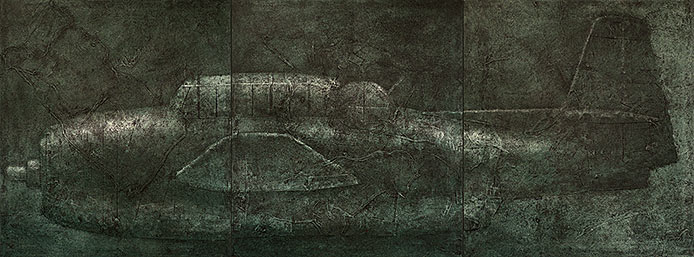
This is a large, three-panel painting of a Grumman Avenger torpedo dive-bomber from World War II. I first heard about this plane from Joan Schonthaler the daughter of one of its pilots. She very kindly sent me photographs of her father in his war time flying days,  along with copies of his own photographs from that era. Here is Lt. Commander Kurt Schonthaler, flying a Grumman Avenger from the aircraft carrier Intrepid (nicknamed “The Fighting I” a reputation gained in the ferocious air and sea battles between Allied and Japanese Imperial forces). His daughter Joan says that her father never mentioned his wartime service unless you asked him. One can only imagine the terrible mix of exhilaration and dread flying one of these dive bombers through the firepower of a stubborn and desperate adversary. I think about these men and women who went off to the Second World War and how many of
along with copies of his own photographs from that era. Here is Lt. Commander Kurt Schonthaler, flying a Grumman Avenger from the aircraft carrier Intrepid (nicknamed “The Fighting I” a reputation gained in the ferocious air and sea battles between Allied and Japanese Imperial forces). His daughter Joan says that her father never mentioned his wartime service unless you asked him. One can only imagine the terrible mix of exhilaration and dread flying one of these dive bombers through the firepower of a stubborn and desperate adversary. I think about these men and women who went off to the Second World War and how many of them never made it back home to the U.S. Those who did settled into an age of revived national wealth and civic pride; they did the best they could to forget the horrific scenes of war. Those of us born soon afterwards – so-called baby boomers – grew up in an innocent warmth of prosperity, peace, and buried secrets; so many of us with only the most distant knowledge of the global cataclysm that preceded us. Oh yes, the painting of the Grumman Avenger: it's acrylic and collage on canvas 40 by 108 in. You can see a series of these World War II planes, called Aviation elsewhere on this website.
them never made it back home to the U.S. Those who did settled into an age of revived national wealth and civic pride; they did the best they could to forget the horrific scenes of war. Those of us born soon afterwards – so-called baby boomers – grew up in an innocent warmth of prosperity, peace, and buried secrets; so many of us with only the most distant knowledge of the global cataclysm that preceded us. Oh yes, the painting of the Grumman Avenger: it's acrylic and collage on canvas 40 by 108 in. You can see a series of these World War II planes, called Aviation elsewhere on this website.
New Moon ~ January 20th, 2015
Kathy's Pears

This triptych of bosc pears appeared on my very first website, launched about thirteen years ago. I decided to bring it out again in celebration of my newly renovated version. I didn't know how to work a website in its first years and I pretty much abandoned it for way too long; I thought of it as being like a ghost ship drifting unattended and at the mercy of currents and winds, maybe even a topic of derision. This pear image was accompanied on that first website by a quote from the 17th century philosopher Francis Bacon. He said, “The contemplation of things as they are, without error or confusion, without substitution or imposture, is in itself a nobler thing than a whole harvest of invention.” Well, okay.
Full Moon ~ January 4th, 2015









 along with copies of his own photographs from that era. Here is Lt. Commander Kurt Schonthaler, flying a Grumman Avenger from the aircraft carrier Intrepid (nicknamed “The Fighting I” a reputation gained in the ferocious air and sea battles between Allied and Japanese Imperial forces). His daughter Joan says that her father never mentioned his wartime service unless you asked him. One can only imagine the terrible mix of exhilaration and dread flying one of these dive bombers through the firepower of a stubborn and desperate adversary. I think about these men and women who went off to the Second World War and how many of
along with copies of his own photographs from that era. Here is Lt. Commander Kurt Schonthaler, flying a Grumman Avenger from the aircraft carrier Intrepid (nicknamed “The Fighting I” a reputation gained in the ferocious air and sea battles between Allied and Japanese Imperial forces). His daughter Joan says that her father never mentioned his wartime service unless you asked him. One can only imagine the terrible mix of exhilaration and dread flying one of these dive bombers through the firepower of a stubborn and desperate adversary. I think about these men and women who went off to the Second World War and how many of them never made it back home to the U.S. Those who did settled into an age of revived national wealth and civic pride; they did the best they could to forget the horrific scenes of war. Those of us born soon afterwards – so-called baby boomers – grew up in an innocent warmth of prosperity, peace, and buried secrets; so many of us with only the most distant knowledge of the global cataclysm that preceded us. Oh yes, the painting of the Grumman Avenger: it's acrylic and collage on canvas 40 by 108 in. You can see a series of these World War II planes, called
them never made it back home to the U.S. Those who did settled into an age of revived national wealth and civic pride; they did the best they could to forget the horrific scenes of war. Those of us born soon afterwards – so-called baby boomers – grew up in an innocent warmth of prosperity, peace, and buried secrets; so many of us with only the most distant knowledge of the global cataclysm that preceded us. Oh yes, the painting of the Grumman Avenger: it's acrylic and collage on canvas 40 by 108 in. You can see a series of these World War II planes, called 